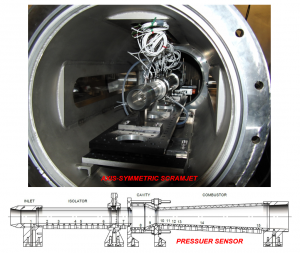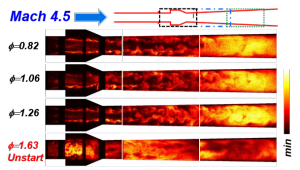ACT-II (Arc Heated Combustion Tunnel-II) is a new plasma arc heated supersonic combustion tunnel at the University of Illinois. The original ACT-I, which was conceived, designed, and built by Professor Hyungrok Do (currently at Seoul National University) and located at the University of Notre Dame and was the forerunner to the current model. ACT-II is equipped with enhanced optical access, a stable and adjustable two stage plasma arc heating system with a NOx minization flow control originally deployed in ACT-I. Operational Mach numbers are from 4.5 to 10 (freestream) and the combustor can be operated in both a free flow and direct connect configurations. In addition to the rectangular scramjet configurations previously utilized in ACT-I, ACT-II was optimized for an axis-symmetric circular combustor in addition to rectangular configurations. Operational test time for ACT-II is a full second, whereas typical flame stabilization occurs within 40 ms of fuel injection.

ACT-II Facility at the University of Illinois
ACT-II was mainly funded by the Air Force Office of Scientific Research and currently is being used for investigation of flame stabilization in axis-symmetric scramjet geometries and unstart phenomenon as a function of unlet flow dynamics. The first axis-symmetric optically accessible scramjet in the freeflow configuration is shown below.

The optically accessible scramjet allows the visualization of high speed flame propagation using advanced diagnostics. Shown below are a set of preliminary PLIF images shown of supersonic flame propagation in the ACT axis-symmetric combustor. The freestream velocity is Mach 4.5 and ethylene is injected through a radial spray perpendicular to the freestream. A combination of enhanced residence time in the cavity and shock compression from the cavity results in the autoignition and stabilization of the flame.
 PLIF Diagnostics of flame propagation in the axis-symmetric scramjet
PLIF Diagnostics of flame propagation in the axis-symmetric scramjet

